The C.E.O.'s Information Technology Challenge: Creating True Value
Information technology has emerged as a key component of competitive advantage.
(originally published by Booz & Company)Every day, chief executives around the world and their boards of directors make tough investment decisions. They launch products, build plants, sign off on multimillion-dollar acquisitions. As diligent investors, they base their decisions on tangible results supported by detailed financial analyses aimed at building shareholder value.
These same C.E.O.'s and directors must also, however, deal with a new category of investments that refuse to behave typically. These investments involve information technology -- and they are growing in number, breadth and scope.
 I.T. projects run the gamut from fixing the Year 2000, or "Y2K," bug to upgrading worldwide networks, replacing legacy systems and developing Internet capabilities to order products and services. Unquestionably, these investment decisions are difficult. They are often complicated by a slew of obstacles: costs that are difficult to estimate, benefits that might or might not materialize, requirements that evolve and change midstream, all contributing to significant delivery risk. But smart investments in I.T. also offer the promise of huge rewards, and C.E.O.'s realize they must make these investments to remain competitive.
I.T. projects run the gamut from fixing the Year 2000, or "Y2K," bug to upgrading worldwide networks, replacing legacy systems and developing Internet capabilities to order products and services. Unquestionably, these investment decisions are difficult. They are often complicated by a slew of obstacles: costs that are difficult to estimate, benefits that might or might not materialize, requirements that evolve and change midstream, all contributing to significant delivery risk. But smart investments in I.T. also offer the promise of huge rewards, and C.E.O.'s realize they must make these investments to remain competitive.
They also realize the stakes are getting higher. In a fundamental shift in the focus of big-ticket I.T. investments, senior executives now demand that new I.T. investments actually build capabilities rather than just improve ongoing operations. C.E.O.'s are discovering that more of their companies' ability to achieve competitive advantage hinges on delivering critical-path I.T. initiatives. In short, I.T. is more intertwined with executing the corporation's overall business strategy than ever before. Not surprisingly, this has intensified the urgency to build I.T.-enabled capabilities.
Most of us were amused when we first heard the technology community characterize Internet years as "dog years" -- shorthand for the opportunity the Internet presents to achieve business goals as much as seven times faster. But we're not scoffing now. The rapid penetration of the Internet coupled with advances in database technology and the availability of global networks have remarkably shortened the time needed to build new capabilities with I.T. And customer and competitive pressures have compressed both the time available to make decisions and the subsequent startup time needed to launch the new efforts.
Recognizing the increasingly pivotal role of I.T., a growing number of C.E.O.'s have positioned their corporations to leverage I.T., thereby achieving competitive advantage much faster than would have been possible in the not-too-distant past:
Charles Schwab: This leader in the emerging online trading industry provides low-commission, self-directed trading to the individual investor. Schwab created a new channel for investors by developing Internet connections to its existing trading systems. In less than two years, Schwab's online customer base has grown to more than 2 million users, with more than $130 billion in assets.
Cisco Systems: This worldwide leader in networking solutions has a stellar track record of financial performance, market presence and continuous product innovation. Cisco's growth has been fueled by an innovative business model that incorporates an aggressive acquisition strategy, a series of alliances and partnerships and a second-to-none reputation for attracting and retaining the best people. In parallel, Cisco's top priorities include making strategic I.T. investments. Cisco has exploited Internet technology to develop capabilities that facilitate high levels of customer contact and customer service in an open business model. Last year, Cisco handled more than 64 percent of its orders and almost 70 percent of its customer inquiries via the Web.
The Home Depot: The world's largest home-improvement retailer has a proven business model for success: offer a huge selection of in-stock discount merchandise while keeping a knowledgeable and friendly staff on the floor at all times. This model is founded on rapid inventory replenishment, low operating costs and outstanding customer service. A fundamental component of Home Depot's strategy is to build these capabilities by making long-term investments in I.T. Home Depot was one of the first retailers to deploy hand-held computers to better monitor inventory levels and to improve customer service on the floor. The company's track record -- more than 50 quarters of earnings growth -- is extraordinary.
These efforts are in stark contrast to the huge Enterprise Resource Planning software installations and infrastructure renewal projects of the early to mid-1990's. While these projects benefited most corporations by providing them with modern, efficient software, hardware and network systems as they retired outdated and often problematic legacy systems, their track record has been mixed at best. Few of these projects have been delivered on time and on budget. In too many cases, the projects expanded their scope, took twice as long to complete as anticipated and cost two or three times more than expected -- and still did not deliver anything near what they promised. What is more important, most of these projects did not build capabilities (as promised), but merely improved ongoing operations.
Almost every C.E.O. we know has read about not only the well-chronicled I.T. failures but also the emerging corporate success stories based on I.T. When pondering their own upcoming I.T. investments, the concerns C.E.O.'s express echo the questions they ask about all new business opportunities:
- "What level of return should we expect from these investments?" and,
- "If we make the investment, will we realize the anticipated returns?"
But uncertain as they may be about what to do and how to do it, too many C.E.O.'s still feel pressured into making huge I.T. investments because they can find no alternative in the face of overwhelming competitive pressures, compliance issues or long overdue upgrades to out-of-date technology. Too often, C.E.O.'s are forced to make I.T. decisions based on conventional wisdom that is largely rooted in the "improving ongoing operations" rationale. But the shift that we are seeing to an "I.T. as capability builder" mindset is being driven by the realization on the part of C.E.O.'s that I.T. must be an increasingly important part of their agendas -- not only to keep the corporation competitive but also to position it properly for the future. (See Exhibit I.)
The C.E.O.'s challenge in making decisions about I.T. is all about recognizing this fundamental shift in what I.T. can do for a company; truly, what we have here is nothing less than a whole new ball game. Together, the changing business environment and recent advances in Internet, database and network technologies are transforming the array of I.T. opportunities and challenges. Just a few years ago, C.E.O.'s did not worry much about globalization, engaging customers in real time with every transaction or the promise of new electronic market channels. But along came the Internet and guess what? In today's world, opportunities to globalize, engage customers and suppliers in real time and facilitate knowledge-sharing and best practices can be achieved in much less time than anyone ever could have imagined.
This new ball game is literally transforming the corporate landscape. It is forcing corporations to rethink their strategies across entirely different sources of competitive advantage and time-to-market considerations. Paradoxically, while the opportunities for I.T.-enabled competitive advantage are more attractive, the available time for seizing these opportunities has been cut by more than half. And the investments required are materially greater -- commonly $50 million to $100 million, sometimes far more. Undoubtedly, the size and complexity of these investments make them material; they easily cross the corporation's major investment threshold, all hitting the C.E.O.'s radar screen and some even requiring board approval.
Without question, C.E.O.'s must address these challenges using different tools, all directed at realizing the business value from I.T. and doing so more quickly. Realizing value commensurate with the level of I.T. investments will require corporations to position these investments very differently.
POSITIONING FOR COMPETITIVE ADVANTAGE
Most of today's market leaders are emerging from a long trek through major consolidation programs and re-engineering initiatives, all of which had a decided cost-reduction focus. The majority of these programs had large I.T. components, most often E.R.P. software initiatives that were designed to automate the newly engineered business processes and deliver a consistent view of all information across the corporation. These E.R.P. projects involve replacing the corporation's core legacy information systems -- the older, widely used systems that employ outdated technology and are focused on a single function, generally in areas such as financial accounting, human resources and purchasing. Quite often, such E.R.P. projects require investments in the $50 million to $100 million range, and sometimes substantially more.
To gain insights into why these huge I.T. investments haven't delivered commensurate value, we analyzed a range of I.T. investments at more than 100 top corporations and found that many shared a common theme. What we found was a fundamental disconnect between what the C.E.O.'s thought they were buying and what the projects really were. In short, to sell these projects to the C.E.O. or board, software suppliers and I.T. managers alike positioned many of them as initiatives that would deliver strategic or step-level changes in competitive advantage; however, in reality, most of the programs were simply upgrades or replacements of legacy systems and outmoded telecommunications infrastructure or compliance-driven fixes to the Y2K bug. Most were undoubtedly necessary upgrades that allowed corporations to retire old technology or to standardize the data used corporation-wide. When we unravel the costs and benefits, however, the majority of these programs can best be described as a cost of doing business rather than as an investment in competitive advantage.
Now that many of these huge I.T. efforts focusing on ongoing operations have been completed, C.E.O.'s are struggling with what lessons their corporations can take away. As a result of their trial by fire, many C.E.O.'s have developed an intimate level of understanding about the difficult challenges and opportunities that are part of today's I.T. world. Most remain steadfastly focused on coming to grips with how they can realize the value from the next wave of I.T. investments. The majority ask the same basic questions:
- "How can we realize the value of our investments in I.T. projects?"
- "How can we take advantage of the opportunities that the new I.T. promises without mortgaging our future?"
- "Why can't we manage the returns on our I.T. investments with any degree of certainty and confidence?"
Unfortunately, these questions do not elicit any easy answers. First and foremost, C.E.O.'s must understand that, when it comes to trying to deploy I.T. to build competitive advantage, one size does not fit all. The next step is to understand their own corporate profile -- the company's competitive positioning, its business strategy and the method by which the corporation currently deploys I.T. What works for one company with its individual competitive position and unique set of market-driving capabilities and I.T. capabilities may not work for another, even if the two have similar positions in the market and offer similar products or services to the same customer segment.
Grounding I.T. investments in the business strategy and the competitive positioning of the corporation may sound relatively simple. Indeed, many top executives believe that aligning the I.T. strategy with the business strategy is the key to solving this problem. But in our view, this approach fails to get at the root of the real issues. The challenge is not to make sure that two strategy documents line up. Rather, the foundation for repositioning the corporation's I.T. investments must be grounded in an objective assessment along four key dimensions. (See Exhibit II.) The four assessment categories are quite straightforward:
- Market-driving capabilities: those capabilities in which excellence yields a sustainable competitive advantage and allows the leaders to drive the market -- Dell's "build to order" business model, for example.
- Role and impact of I.T.: the way in which I.T. can deliver or support each market-driving capability.
- Current investment portfolio: the prioritized investment opportunities, both I.T.-centric and non-I.T.-related, about which the corporation must make decisions.
- I.T. cost and investment profile: the detailed breakdown of the corporation's budget for I.T., including ongoing costs and one-time investments.
This objective assessment of market-driving capabilities must serve as the basis for deciding I.T.'s role in delivering the respective capabilities. Without it, subsequent I.T. projects will likely be doomed to fail. Surprisingly, we have found that many of the corporations that are market leaders in their industries have not prioritized their I.T. investments to support their business strategies.
In our work with C.E.O.'s, the most difficult analyses usually involve understanding the corporation's I.T. costs. We often find considerable "hidden" costs in operating units and departments that purchase their own personal computers and software and oversee their own maintenance and support.
The cost analysis is often complicated, but the results always provide some compelling insights. In nearly all major corporations, when the total I.T. costs are aggregated, about two-thirds of the annual I.T. costs are fixed and are therefore allocated -- at least in the short term -- to ongoing operations, such as the data centers, the networks and all the required supporting infrastructure. The remainder is discretionary; it is what is "available" for I.T. investments that can help build new market-driving capabilities.
Realizing that only about a third of their corporations' I.T. spending is available to build capabilities is a rude awakening for many C.E.O.'s, especially as they are already lamenting how much they spend with so few tangible returns. In reality, the actual dollars earmarked for development are often substantially less than a quarter of I.T. spending, since these monies are typically allocated across both new development and continuing maintenance and enhancement activities.
Analyzing the corporation's I.T. costs is fundamental to understanding the trade-offs between investing in continuing operations and infrastructure, on one hand, and in building capabilities that can sustain or drive competitive advantage, on the other. Opportunities to leverage scale and achieve cost savings on the operations side can be realized from outsourcing, alliances and partnerships with suppliers. Each of these options presents trade-offs between cost savings and control. C.E.O.'s and senior executives must consider whether they want to invest in building capabilities across all dimensions of their I.T. operations or whether they want to reallocate existing funds to capability-building for the corporation. We are seeing a growing number of senior executives who want to know their corporation's I.T. costs and investment priorities so they can understand their options for reallocating funds to capability-building initiatives.
Developing a full understanding of all I.T. costs as well as current investment performance is a critical step toward repositioning the corporation to use I.T. to build market-driving capabilities. With the changing corporate landscape resulting from the consolidations and globalization initiatives of the early 1990's -- and the continuing pressure to deliver short-term performance -- it is prudent for all C.E.O.'s to make sure that their corporations undertake the necessary analyses of the full range of their I.T. costs and investments.
A WHOLE NEW BALL GAME
Recognizing that I.T. costs and investments are growing is only the beginning. The real breakthrough comes in understanding the corporation's potential to improve its future I.T. investment performance. Making investments that can deliver competitive advantage requires a thorough understanding of the impact they can have on your company's operations and strategy -- changes that are likely to be realized much more quickly than ever before.
Fundamental to this understanding is the recognition that today's business environment for building competitive advantage is undergoing a major transformation, driven by three key principles:
1. Emphasis is shifting toward the potential value delivered by I.T. outside the corporation. Most corporations have completed significant E.R.P. software installations and network infrastructure projects as major improvements to their internal I.T. operations. We are now seeing a shift in I.T. projects to external opportunities that engage customers, suppliers and alliance partners as part of the corporation's "extended enterprise." Examples include new channels, order management, customer service and brand-building, all enabled by Internet technology and its universal reach.
2. Internet capabilities are affecting strategy, competitive positioning and business models of many corporations. The Internet has presented new opportunities and challenges for corporations to build competitive advantage. Competition and customer needs will continue to drive demand as corporations begin to reposition their capabilities to take advantage of new channels, new cost structures and new business models, most of which did not exist two years ago. The promise of electronic commerce also presents additional challenges in restructuring pieces of the existing order management, customer and supplier capabilities and their supporting infrastructure.
3. Traditional value chains are being restructured by "disintermediating" the middleman. The Internet provides a low-cost, universal medium for suppliers to connect with customers. Whether existing businesses or distributors are vulnerable will depend to a large extent upon how well they provide alternative capabilities or enhance their existing offerings. Smart companies like Schwab are exploiting the new channel opportunities by building Internet-access capabilities and integrating across their traditional product offerings to offer alternatives. The challenge is to understand where the risks are likely to be and build alternative capabilities, or risk "disintermediation."
C.E.O.'s and their management teams must understand how this changing business environment affects their capacity to make successful investments in I.T. (See Exhibit III.) C.E.O.'s now have the imperative to get I.T. decisions right the first time. It is critical for C.E.O.'s to recognize not only that the opportunity for building competitive advantage with I.T. is far greater than before, but also that the time frame available for realizing value from I.T. is far narrower. This is further complicated by both the ever-increasing size of I.T. investments and the rapid adoption rate of new I.T. solutions by customers and competitors alike. All these factors underscore the importance of making I.T. investment decisions in the context of the corporation's overall investment priorities.
One of the best examples we've seen of a company successfully melding its I.T. investments with its business priorities is the Capital One Financial Corporation, the leading credit-card issuer in the United States. As discussed in the accompanying article, Capital One's entire business model is predicated on using I.T. to achieve business goals. The Dell Computer Corporation and Cisco are other good examples of companies making strategic investments in I.T. with the goal of marrying their business models, market strategies and I.T. capabilities.
When determining their corporations' priorities for building market-driving capabilities with I.T., the next challenge for C.E.O.'s revolves around how the I.T. function is managed. There are two basic models for managing I.T. -- cost and value -- and each has its own implications for spending levels and potential investment dollars. (See Exhibit IV.)
Most corporations adopt one I.T. management model based on their own priorities and strategies, but some use a hybrid approach, separating the scale-intensive functions (for example, data center operations, network infrastructure and support activities) from the value-oriented ones. The differences between approaches are clear:
- Cost Model: The cost model requires a commitment to maintaining an operating environment that relies on mature hardware, software and network architecture, with proven products that are stable and well understood by the staff.
- Value Model: The value model is predicated on meeting the specific needs of the business community, often trading cost efficiency for new capability-building activities. In this model, business executives either wield a great deal of influence or control their own I.T. funding and resources.
- Hybrid Model: The hybrid model evolves when corporations try to optimize on both the cost and value dimensions. The operating components and the capability-building resources are often separated, sometimes with different managers leading each.
Over the past few years, we have seen more companies trying to use the hybrid model. This reflects the evolving partnership between the I.T. function and the business community, as well as the increasingly urgent need to look at a corporation's I.T. spending and investment performance across major I.T. projects.
Few corporations follow the pure value approach to I.T. management, but we are seeing a new breed of chief information officer whose management objectives are truly value-based. Gary Reiner of The General Electric Company is a good example. Mr. Reiner joined G.E. to head one of the corporate strategy groups and worked on a number of mission-critical efforts, including accelerating product development and shortening supply lines, for five years before being appointed C.I.O. in 1996. Mr. Reiner's charge is "to make information technology a competitive advantage for G.E." Putting him in charge of G.E.'s worldwide investments in I.T. sent a clear signal that G.E. was getting serious about exploiting I.T. for value, across divisions and around the world.
G.E. is not alone. We are seeing more and more examples of major corporations repositioning their I.T. investments to build competitive advantage. As we track the growth of the Internet and the recent penetration of electronic commerce in many sectors, it is clear that the way many corporations do business will change significantly. Using new and different channels will change not only the way they do business with customers, but also their cost structures. This changing business environment requires different business models, processes and relationships. One size may not fit all, but the imperative fits everyone: C.E.O.'s must assess their corporations' I.T. capabilities and investment performance with an understanding of the whole new ball game.
WHAT CAN THE C.E.O. DO?
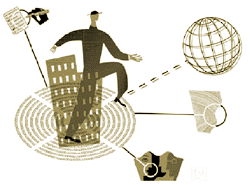 Probably the earliest and certainly the most prominent example of a C.E.O. recognizing the potential for I.T. was General Electric's Jack Welch, who drove the proverbial stake into the ground in 1995 when he characterized I.T. in G.E.'s annual report as "one of the top five growth initiatives that the company has ever faced." This was the same year Microsoft recognized that it needed an Internet browser capability to compete effectively in the future.
Probably the earliest and certainly the most prominent example of a C.E.O. recognizing the potential for I.T. was General Electric's Jack Welch, who drove the proverbial stake into the ground in 1995 when he characterized I.T. in G.E.'s annual report as "one of the top five growth initiatives that the company has ever faced." This was the same year Microsoft recognized that it needed an Internet browser capability to compete effectively in the future.
Quite simply, for most corporations, we see little room for debate: I.T. must be on the C.E.O.'s agenda because too many high-priority agenda items rely on it for delivery and execution. And the C.E.O. needs to lead the initiative so that the rest of the management team and the corporation as a whole will understand the urgency and potential impact.
Going forward, the corporate I.T. imperative is clearer than ever; it is driving C.E.O.'s and management teams toward four key initiatives:
1. Make I.T. a key part of the C.E.O. agenda. The biggest decision the C.E.O. can make is to elevate I.T. to the ranks of the top-priority, highest-visibility opportunities for the corporation. The visibility alone will help keep the management team focused on every opportunity to build competitive advantage as well as on improving returns on the corporation's I.T. investments.
2. Manage for value creation.The C.E.O. and the management team must decide whether (and if so, to what extent) they want to control I.T. costs and/or build capabilities with I.T. The key here lies in recognizing that this decision drives the entire opportunity to build competitive advantage with I.T., so it must line up with the corporation's overall market strategy. Managing for value requires that I.T. investments be a key part of the business strategy and be focused on building capabilities as an explicit management objective.
3. Manage I.T. spending and investment priorities in line with the corporation's overall investment priorities. After determining the overall investment strategy and the proper role of I.T., the C.E.O. and management team must drive the implementation of the investment projects with a focus on demonstrable results.
4. Deploy the best I.T. management model. This decision must be explicit and tied to the corporation's potential to build competitive advantage with I.T. There are three options: the cost model, the value model or a hybrid model that draws on the key objectives of both.
We believe most C.E.O.'s recognize that too much is at stake for any corporation to disregard the potential that I.T. represents in the emerging Information Age. While a corporation's potential for leveraging I.T. to build competitive advantage will vary according to industry, competitive position and existing capabilities, the issues that ultimately force C.E.O.'s to take action will likely come from customers and competitors.
C.E.O.'s now have before them a vast array of I.T. opportunities that can affect virtually every function and every capability in the corporate portfolio. To capitalize on these opportunities, C.E.O.'s must understand how they can use I.T. to achieve many fundamental goals and thereby build shareholder value. The early winners have already figured out that tomorrow's opportunities for competitive advantage will be driven by information and the ability to use it, in real time, across an increasingly complex, global landscape.
At the Capital One Financial Corporation, one of the largest providers of MasterCard and Visa credit cards in the world, information technology is completely intertwined with the business and has been since the company's founders embarked on a mission to market credit cards to different types of customers just over a decade ago.
Based in Falls Church, Va., Capital One is a financial services company that employs an information-based strategy to target and secure customers. By using proprietary integrated systems to manage large volumes of data, the company continually tests new product offerings and pricing combinations on an array of products, including numerous Platinum and Gold credit cards as well as secured and customized credit cards for consumers with limited credit history. As of June 1998, Capital One had more than 13.5 million customers, $15 billion in managed loans and information on approximately 120 million households in the United States, Canada and Britain.
The company had its beginnings in 1987 when two former banking-industry consultants, Nigel Morris and Richard Fairbank, concluded that the field was wide open for credit-card companies that could anticipate credit terms that would appeal to very targeted sets of customers. While pitching this marketing concept to banks across the country, they also met with representatives from the Oracle Corporation to discuss distributed relational database technology. Their vision was a system into which they could pour all kinds of information -- credit-card bureau data, demographics, purchased lists -- then have the system crunch through hundreds of what-if scenarios to spit out carefully screened lists of consumers.
Within 18 months, Mr. Morris and Mr. Fairbank had signed a deal with Signet Bank to market targeted credit cards. Their concept paid off more quickly than they anticipated: In one year, they doubled the number of Signet cardholders to 2 million.
The real challenge came in 1994, when Signet spun off its credit-card division to form Capital One Financial. Although the information-enabled marketing strategy continued to prove successful, the systems supporting the strategy had become woefully inadequate over the years. Critical information management had been outsourced, and legacy mainframe systems were outdated. To make matters worse, the I.T. function itself was organized in a traditional hierarchy that did little to foster innovative and effective application development.
Enter new chief information officer Jim Donehey, formerly executive director of I.T. in Europe for Goldman Sachs. Mr. Donehey recognized that Capital One's systems were held together with masking tape and bubble gum, but he also saw the tremendous opportunity. Over the next several years, Mr. Donehey, along with Mr. Morris, the chief operating officer, and Mr. Fairbank, the chief executive, led a billion-dollar-plus investment in I.T.
The threesome immediately got rid of the traditional, compartmentalized I.T. organization in which marketing, sales, human resources and finance departments each determined their own I.T. needs and approached programmers to deliver solutions. Scrapping the service-station model of I.T. management, Capital One envisioned a management triangle in which new initiatives would be run by one representative each from I.T., operations and corporate strategy. This triumvirate's mission was to break up departmental logjams and let development managers focus on overarching business rationales. To increase the flow of ideas, Mr. Donehey eliminated the position of head of application development and created the new position of business information officer, who would deliver the best solution for the business rather than shopping the latest technology around to the different departments.
After they broke down organizational barriers, Capital One's senior executives turned their attention to the metrics used to analyze I.T. investments. Instead of relying on orthodox return-on-investment figures, which do not give any sense of the size of the investments being evaluated, they decided to use net-present-value calculations. This helped the executives better understand how to invest to maximize their resources; the method proved so successful that it has since become the company-wide standard metric.
At the same time, the company invested tens of millions of dollars in replacing and modernizing legacy systems so business strategy would be supported more effectively. Now, more than 100 production databases plow through more than 7,000 live product tests each year. More than 10 million accounts, averaging 14 transactions a month apiece, are serviced daily. In September 1997, Capital One went live with an object-based business application, and over the next two to three years it will replace remaining mainframes and client-server and desktop applications with a distributed, three-tier architecture because senior executives realized that using a more modern architecture would enable Capital One's systems to adjust rapidly to changing business conditions.
At Capital One, I.T. not only enables market-driving capabilities, it actually creates revenue opportunities. With its proprietary information-based strategy, its enormous database of current and potential customers, and its computer-driven models with data-mining techniques employing actuarial and behavioral principles, Capital One can predict individual risk patterns and constantly uses them to develop new marketing opportunities. In 1997 alone, Capital One's customer base grew by 40 percent. In less than 10 years, the company has increased the value of loans managed from $1 billion to more than $15 billion. And since 1994, shareholder value has risen from less than $20 a share to a high in 1998 of nearly $130, with a market capitalization of more than $6 billion. ![]()
Reprint No. 99108

